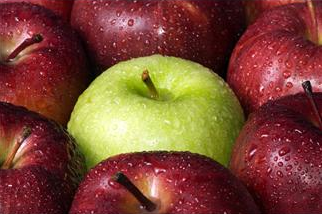 I just finished enjoying my morning fiber-rich snack that I made myself with buckwheat, chia, hemp seeds, goji berries and cinnamon. As I was sitting here feeling my bowels thank me, I got to thinking, “what is it that many other people eat for a snack if they want to increase the fiber in their diet?” I asked around the office and a common response was All-Bran bars or Fiber1 bars. The names themselves scream, “You need to eat me! I’m healthy and full of fiber!” Being the skeptic that I am when it comes to product packaging and marketing, I decided to look into what these products contain to see if they lived up to all their claims. Let’s have a look at what I found out about the All-Bran bars when I started to undress their dirty little secrets.
I just finished enjoying my morning fiber-rich snack that I made myself with buckwheat, chia, hemp seeds, goji berries and cinnamon. As I was sitting here feeling my bowels thank me, I got to thinking, “what is it that many other people eat for a snack if they want to increase the fiber in their diet?” I asked around the office and a common response was All-Bran bars or Fiber1 bars. The names themselves scream, “You need to eat me! I’m healthy and full of fiber!” Being the skeptic that I am when it comes to product packaging and marketing, I decided to look into what these products contain to see if they lived up to all their claims. Let’s have a look at what I found out about the All-Bran bars when I started to undress their dirty little secrets.
Ingredient list for All-Bran Bars (Chocolate Chip)
Wheat flour, sugar/glucose-fructose, cereal (wheat bran, sugar/glucose-fructose, malt [corn flour, malted barley], salt, vitamins [thiamine hydrochloride, pyridoxine hydrochloride, folic acid, d-calcium pantothenate], iron), vegetable shortening (contains palm and palm kernel oils, TBHQ), chocolate chips (sugar, chocolate liquor, cocoa butter, soy lecithin, vanilla extract), oat hull fibre, dried whole egg, milk ingredients, natural and artificial flavours, salt, baking powder, soy lecithin.
Now that we’ve seen what is in this product, I’m going to share with you the 5 main reasons why they wouldn’t find their way into my grocery cart.
Reason Number 5 – Processed Wheat
The first ingredient is “Wheat Flour”. This is not whole-wheat flour, the type that actually contains fiber. This is the processed wheat flour that has the fiber removed.

This may lead to the question, “if they removed the fiber from the wheat, how do these bars contain fiber?” Great question! What they have done is they have processed the wheat and removed the bran (which is the fiber) and the germ (which contains a lot of nutrients). Then they went and added back in some of the bran so that the bar would have fiber and they could advertise it as such.
The problem is that the wheat is not in its whole form and is not as nutritious. I would prefer to stick to the whole grain as nature intended.
Reason Number 4 – High-fructose Corn Syrup
The second ingredient is suga
 r/glucose-fructose. In Canada glucose-fructose is another name for high-fructose corn syrup. Eating a lot of processed sugars that are nutrient-depleted can lead to problems like high cholesterol, atherosclerosis, heart disease, diabetes, obesity, etc. These should be avoided at all cost.
r/glucose-fructose. In Canada glucose-fructose is another name for high-fructose corn syrup. Eating a lot of processed sugars that are nutrient-depleted can lead to problems like high cholesterol, atherosclerosis, heart disease, diabetes, obesity, etc. These should be avoided at all cost.
I do want to mention here that just because processed and refined sweeteners (the ones that mess up our sexy bodies) should be avoided, doesn’t mean that we can’t have some sweetness in our lives. Honey and maple syrup when used in moderation are great additions to a healthy diet. They not only provide us with important nutritional benefits, they taste great too!
Reason Number 3 – Chemical Preservatives made from Petroleum
These bars contain TBHQ (Tertiary Butylhydroquinone). This is a chemical preservative, a form of butane, and is used to extend the shelf life of the bar and delay rancidness. The American and Canadian governments have allowed companies to put this preservative in foods but have strict restrictions on how much they are allowed to add.
I find it ironic that something could be deemed safe for human consumption and then strictly regulated to ensure we don’t consume too much. What would happen if we did eat too much?
 The problem as I see it is that when these limits are determined, they are determined for a ‘standard’ adult. What if you are a baby and are consuming these preservatives? What if you are consuming a large number of products that contain this preservative and are getting more than the amount found in one All-Bran bar? Or what if you are already full of toxins in your body and consuming this puts your body toxicity levels over the top? The truth is we don’t actually know the answers to these questions.
The problem as I see it is that when these limits are determined, they are determined for a ‘standard’ adult. What if you are a baby and are consuming these preservatives? What if you are consuming a large number of products that contain this preservative and are getting more than the amount found in one All-Bran bar? Or what if you are already full of toxins in your body and consuming this puts your body toxicity levels over the top? The truth is we don’t actually know the answers to these questions.
Everyone is different. We are different sizes, we eat differently, and we have different tolerability levels for toxins. What might be an okay level for one person is different for the next. Therefore, I have a hard time trusting the safety limits that are set for a ‘standard’ adult, especially when it comes to feeding these products to children or people who are ill/toxic (which unfortunately is a large portion of the population).
Personally, I try to stick to foods that are fresh and don’t contain chemical preservatives, especially those that are derived from petroleum.
Reason Number 2 – Artificial Flavours
When we heavily process foods, they lose their flavour. This is why processed foods contain added flavouring. If they didn’t, the food wouldn’t taste very good. These flavours are made in chemistry labs and often contain a whole host of various chemicals. For the most part they are considered safe until there is some concrete evidence that they are harmful. Personally, I think this method is flawed. I think they should be deemed unsafe until proven safe. (Note: Some studies may have been done on a number of these added ingredients but not enough to determine that they are safe when used cumulatively, long term and on various individuals)
The other issue with the
 term “artificial flavours”, is that we actually don’t know what this means and what chemicals are involved. They lump a whole bunch of chemicals into that one term and don’t have to list them separately.
term “artificial flavours”, is that we actually don’t know what this means and what chemicals are involved. They lump a whole bunch of chemicals into that one term and don’t have to list them separately.
An example of a chemical that hides under this name is by a company called Senomyx. They work with Kraft, Nestle, Coca Cola, and Campbell Soup. When this chemical is put in the food it helps to mask the bitter flavour of the food. It does this by turning off the bitter flavour receptor on our tongue. This allows the companies to reduce the amount of sugar and sodium in the product without actually affecting the flavour. It seems like these companies then grab their megaphones and proudly tell the world that they have low-sodium and low-sugar products. This all sounds fine and dandy, but is this new chemical that is being added to my food safe? Apparently there was a 3-month safety study done on rats that resulted in this being safe for long-term human consumption (including children). Seems odd to me.
Personally, I would rather stick to the true natural flavours of foods instead of having my taste buds tricked by chemists in a white lab coat.
Reason Number 1 – There isn’t even that much fiber!!

The amount of fiber you get in one of these bars is 4 grams. This is the same amount of fiber you would get in 1 medium apple.
Conclusion
The next time you reach for an All-Bran cereal bar, keep in mind that you are actually getting processed, refined, and nutrient-poor wheat, high-fructose corn syrup, petroleum preservatives, artificial chemical flavouring agents, and the equivalent amount of fiber to a medium sized apple.
What will you have for your next snack? Let me know in the comments below and/or on The Naked Label facebook page.


